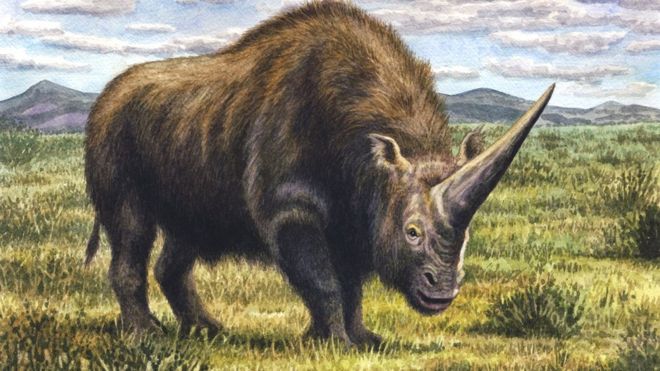Post by dinosauria101 on May 24, 2019 10:06:58 GMT 5
Elasmotherium sibiricum
Elasmotherium ("thin plate beast") is an extinct genus of large rhinoceros endemic to Eurasia during the Late Pliocene through the Pleistocene, existing from 2.6 Ma to at least as late as 39,000 years ago in the Late Pleistocene. E. sibiricum, was the size of a mammoth and is thought to have borne a large, thick horn on its forehead. Theories about the function of this horn include defence, attracting mates, driving away competitors, sweeping snow from the grass in winter and digging for water and plant roots. Like all rhinoceroses, elasmotheres were herbivorous. Unlike any others, its high-crowned molars were ever-growing. Its legs were longer than those of other rhinos and were adapted for galloping, giving it a horse-like gait. The known specimens of E. sibiricum reach up to 4.5 m (15 ft) in body length with shoulder heights over 2 m (6 ft 7 in). Elasmotherium weighed 4.5-5 ton.

Mamenchisaurus hochuanensis
Mamenchisaurus ( /mɑːˈmʌntʃiˈsɔrəs/ mah-MUN-chi-SAWR-əs, or spelling pronunciation /məˌmɛntʃiˈsɔrəs/) was a plant-eating four-legged dinosaur, known for its remarkably long neck, which made up half its total length. It is known from numerous species which ranged in time from 160 to 145 million years ago, from the Oxfordian to Tithonian ages of the late Jurassic Period of China. Mamenchisaurus means 'Mamenchi lizard', from the Chinese Pinyin mǎ (马 'horse') and mén (门 'gate'), while chi is a transliteration of xī (溪 'stream' or 'brook'), combined with the suffix -saurus (from Greek sauros meaning 'lizard'). Mamenchisaurus was first discovered in 1952 on the construction site of the Yitang Highway in Sichuan, China. The partial skeleton fossil was then studied, and named Mamenchisaurus constructus in 1954, by the renowned Chinese paleontologist Professor C. C. Young. The type specimen had an incomplete neck with 14 vertebra preserved and none of these were complete . M. constructus was estimated at 13 m (43 ft) long. In 1972, a second species of Mamenchisaurus was discovered (M. hochuanensis) with a neck that reached up to 9.3 m (31 ft) in length. This species had a complete neck preserved which contained 19 vertebrae. In 1994, Sauroposeidon was discovered in the United States, with a neck estimated to be between 10.5 and 11.5 meters (34.5–37.5 feet) long, though its neck did not exceed that of the previously known Supersaurus, with a neck reaching 13–14 meters (42.5–46 feet).
NOTE: We are using the 22 meter, 18 tonne Mamenchisaurus hochuanensis for this matchup,

Credit to Wikipedia
Elasmotherium ("thin plate beast") is an extinct genus of large rhinoceros endemic to Eurasia during the Late Pliocene through the Pleistocene, existing from 2.6 Ma to at least as late as 39,000 years ago in the Late Pleistocene. E. sibiricum, was the size of a mammoth and is thought to have borne a large, thick horn on its forehead. Theories about the function of this horn include defence, attracting mates, driving away competitors, sweeping snow from the grass in winter and digging for water and plant roots. Like all rhinoceroses, elasmotheres were herbivorous. Unlike any others, its high-crowned molars were ever-growing. Its legs were longer than those of other rhinos and were adapted for galloping, giving it a horse-like gait. The known specimens of E. sibiricum reach up to 4.5 m (15 ft) in body length with shoulder heights over 2 m (6 ft 7 in). Elasmotherium weighed 4.5-5 ton.

Mamenchisaurus hochuanensis
Mamenchisaurus ( /mɑːˈmʌntʃiˈsɔrəs/ mah-MUN-chi-SAWR-əs, or spelling pronunciation /məˌmɛntʃiˈsɔrəs/) was a plant-eating four-legged dinosaur, known for its remarkably long neck, which made up half its total length. It is known from numerous species which ranged in time from 160 to 145 million years ago, from the Oxfordian to Tithonian ages of the late Jurassic Period of China. Mamenchisaurus means 'Mamenchi lizard', from the Chinese Pinyin mǎ (马 'horse') and mén (门 'gate'), while chi is a transliteration of xī (溪 'stream' or 'brook'), combined with the suffix -saurus (from Greek sauros meaning 'lizard'). Mamenchisaurus was first discovered in 1952 on the construction site of the Yitang Highway in Sichuan, China. The partial skeleton fossil was then studied, and named Mamenchisaurus constructus in 1954, by the renowned Chinese paleontologist Professor C. C. Young. The type specimen had an incomplete neck with 14 vertebra preserved and none of these were complete . M. constructus was estimated at 13 m (43 ft) long. In 1972, a second species of Mamenchisaurus was discovered (M. hochuanensis) with a neck that reached up to 9.3 m (31 ft) in length. This species had a complete neck preserved which contained 19 vertebrae. In 1994, Sauroposeidon was discovered in the United States, with a neck estimated to be between 10.5 and 11.5 meters (34.5–37.5 feet) long, though its neck did not exceed that of the previously known Supersaurus, with a neck reaching 13–14 meters (42.5–46 feet).
NOTE: We are using the 22 meter, 18 tonne Mamenchisaurus hochuanensis for this matchup,

Credit to Wikipedia







